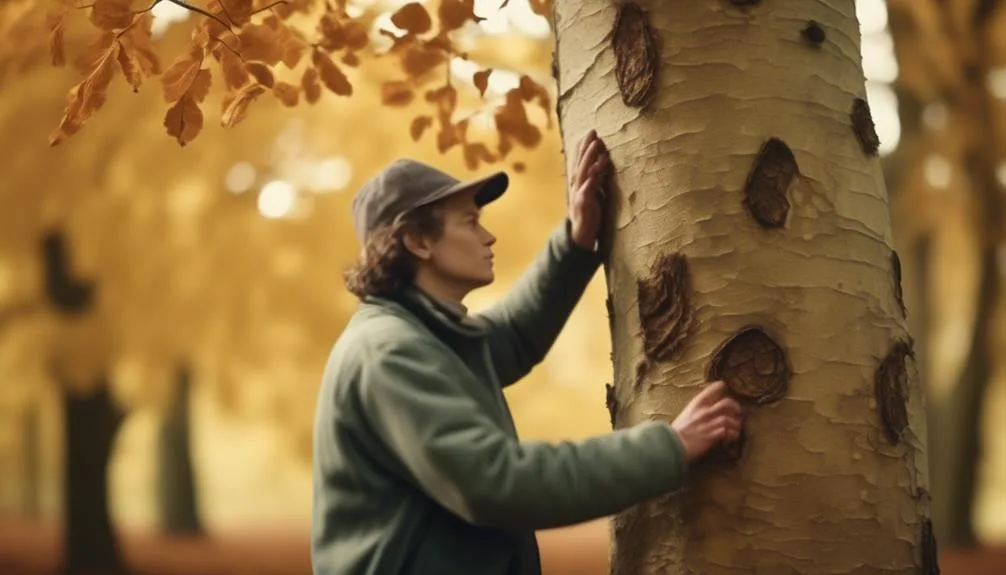Dealing with beech tree diseases can be a challenge, but there are eco-friendly ways to manage them. By using organic treatments and good tree care, you can help your beech trees stay healthy and fight off diseases without using harsh chemicals.
With some knowledge and effort, you can take steps to protect your beech trees from future outbreaks and keep them in good shape for the long haul.
Identifying Beech Tree Diseases
When inspecting beech trees for diseases, look for symptoms such as leaf discoloration, unusual growths, or dieback of branches.
Beech trees can be affected by various diseases, including beech bark disease, beech leaf disease, and powdery mildew.
Beech bark disease symptoms include cankers on the bark and a fuzzy white coating on the trunk.
Beech leaf disease causes dark striping or banding on the leaves, leading to leaf deformities.
Powdery mildew appears as a white powdery substance on the leaves.
Identifying these disease symptoms early is crucial for effective pest control.
Regularly inspect your beech trees and promptly address any signs of disease to prevent further spread and damage.
Proper management and organic pest control methods can help maintain the health of your beech trees.
Organic Treatment Options
To manage beech tree diseases organically, consider implementing a combination of cultural practices and natural remedies to promote tree health and combat pests effectively.
Natural remedies such as neem oil, garlic spray, or horticultural oil can be effective eco-friendly solutions for controlling common beech tree diseases like powdery mildew or beech bark disease. Neem oil, derived from the seeds of the neem tree, acts as a natural insecticide and fungicide, combating a range of pests and diseases.
Garlic spray, made from garlic bulbs and water, can help deter pests and boost the tree's natural defenses. Additionally, horticultural oils suffocate pests and their eggs, making them a safe and effective option for managing certain tree diseases.
Incorporating these natural remedies into your organic management plan can help maintain a healthy beech tree population without harmful chemicals.
Proper Tree Care Practices
Implementing proper tree care practices is essential for maintaining the health and resilience of beech trees in an organic management approach. When it comes to pruning techniques, it's crucial to remove dead or diseased branches promptly to prevent the spread of diseases.
Additionally, proper pruning can improve air circulation and sunlight penetration, promoting overall tree health. Regularly inspect your beech trees and prune them during their dormant season to minimize stress.
Moreover, maintaining soil health is vital for beech tree care. Ensure the soil is well-draining and rich in organic matter to support the tree's growth and resilience to diseases. Mulching with organic materials can help retain soil moisture and improve its structure.
Preventing Future Disease Outbreaks
To prevent future disease outbreaks in your beech trees, it's crucial to maintain good sanitation practices in your garden or landscape. Here are four essential tips to help you prevent future disease outbreaks and promote the health of your beech trees:
- Regularly prune and remove dead or diseased branches to prevent the spread of pathogens.
- Implement natural remedies such as neem oil or compost tea to boost tree immunity and combat potential disease-causing agents.
- Select disease-resistant beech tree varieties when planting new trees to minimize the risk of infections.
- Keep the area around your beech trees clean and free of debris to reduce the likelihood of harboring disease-causing organisms.
Monitoring Tree Health and Progress
Regularly monitoring the health and progress of your beech trees is essential for identifying early signs of disease, nutrient deficiencies, or other issues that may impact their well-being.
Tracking growth allows you to assess the overall health of your trees and catch any abnormalities early on. Keep an eye on the development of new leaves and branches, as stunted growth or discoloration could indicate underlying problems.
Additionally, observing the disease resistance of your beech trees is crucial. Look for any signs of pests or diseases, such as unusual spots on the leaves or visible damage to the bark.
Conclusion
By being proactive and using organic treatments, you can effectively manage beech tree diseases while promoting a healthy and sustainable environment for your trees.
Regular monitoring and proper care are key to ensuring the longevity and beauty of your beech trees.
With dedication and eco-friendly practices, you can safeguard your trees for the years ahead.

My interest in trees started when I first saw the giant sequoias in Yosemite.
I was a teenager then, and I remember thinking, “I need to learn more about this.”
That moment stuck with me.
A few years later, I went on to study forestry at Michigan Tech.
Since graduating, I’ve worked in a mix of hands-on tree care and community education.
I’ve spent over ten years helping people understand how to plant, maintain, and protect the trees in their neighborhoods.
I don’t see trees as just part of the landscape.
They are living things that make a real difference in our daily lives.
